Search
- Page Path
-
- HOME
- Search
- Review article
- Recent advances in food allergen immunotherapy
- You Hoon Jeon, Edwin H. Kim
-
Food allergies can pose significant risks and profoundly impact the quality of life of children and their families, making them a major public health concern. Allergen avoidance has been the traditional mainstay of treatment; however, recent research has focused on various approaches to food allergen immunotherapy. This review summarizes the recent advancements in oral, sublingual, and epicutaneous immunotherapies, highlighting their... -
DOI: https://doi.org/10.3345/cep.2023.01004 [Accepted]
- Original Article
- Neurology
- Effectiveness of Helmet therapy for infants with moderate to severe positional plagiocephaly
- Jeongho Kim, Jina Kim, Kyu Young Chae
- Clin Exp Pediatr. 2024;67(1):46-53. Published online December 5, 2023
-
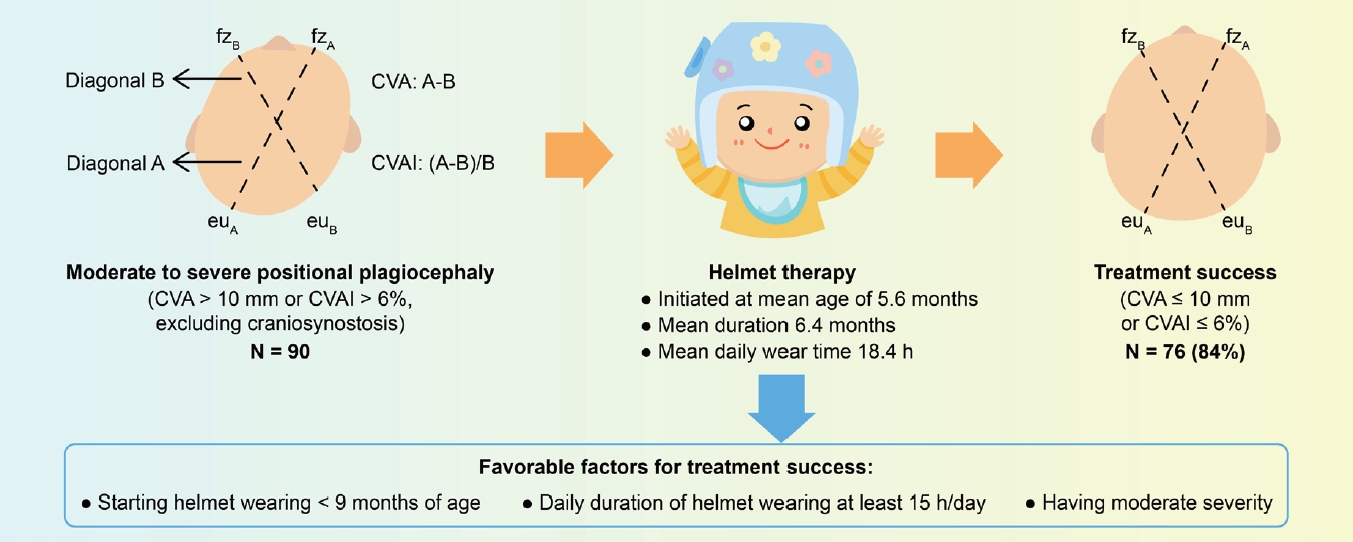
Question: Is helmet therapy effective for positional plagiocephaly? What factors influence helmet therapy efficacy for positional plagiocephaly?
Finding: Helmet therapy is effective for infants with moderate to severe positional plagiocephaly, and its effectiveness is influenced by age at treatment initiation, severity of head asymmetry, and daily duration of helmet wear.
Meaning: Pediatricians should initiate helmet therapy for positional plagiocephaly sooner, ideally before 9 months of age, to maximize treatment efficacy.
- Review Article
- Allergy
- Practical issues of oral immunotherapy for egg or milk allergy
- Sukyung Kim, Kangmo Ahn, Jihyun Kim
- Clin Exp Pediatr. 2024;67(3):140-148. Published online June 19, 2023
-

· Oral immunotherapy should be supervised by pediatricians with experience administering oral food challenge tests and managing allergic reactions.
· Food allergen intake is gradually increased and maintained for years.
· Patients may experience allergic reactions and psychological problems.
· Adjunctive therapies (biologics, antihistamines, and leukotriene receptor antagonists) may improve efficacy and safety.
· Contraindications include uncontrolled asthma, malignancy, active autoimmune disorders, and beta-blocker usage.
- New approaches to immunotherapy in house dust mite allergy
- In Sik Kim
- Clin Exp Pediatr. 2023;66(4):161-168. Published online October 25, 2022
-

Allergen immunotherapy (AIT) has developed over the last few decades and has emerged as a promising treatment. House dust mite (HDM) is a target allergen in AIT, and various modified HDM allergens have been improved for their efficacy. Moreover, clinical trials have proved their significantly therapeutic effects in allergy. This article review focuses on HDM allergens developed for AIT efficacy,...
- Original Article
- Oncology
- Treatment outcomes of high-dose chemotherapy plus stem cell rescue in high-risk neuroblastoma patients in Thailand
- Kunanya Suwannaying, Piti Techavichit, Patcharee Komvilaisak, Napat Laoaroon, Nattee Narkbunnam, Kleebsabai Sanpakit, Kanhatai Chiengthong, Thirachit Chotsampancharoen, Lalita Sathitsamitphong, Chalongpon Santong, Panya Seksarn, Suradej Hongeng, Surapon Wiangnon
- Clin Exp Pediatr. 2022;65(9):453-458. Published online May 24, 2022
-

Question: This study aimed to elucidate the outcomes of high-risk neuroblastoma (HR-NB) patients treated with high-dose chemotherapy and stem cell rescue without immunotherapy.
Finding: The 5-year overall survival and event-free survival rates were 45.1% and 40.4%, respectively.
Meaning: High-dose chemotherapy plus stem cell rescue followed by cis-retinoic acid for 12 months is well tolerated and could improve survival in patients with HR-NB in limited resource settings.
- Neonatology (Perinatology)
- Comparison of minimally invasive surfactant therapy with intubation surfactant administration and extubation for treating preterm infants with respiratory distress syndrome: a randomized clinical trial
- Mohammad Kazem Sabzehei, Behnaz Basiri, Maryam Shokouhi, Sajad Ghahremani, Ali Moradi
- Clin Exp Pediatr. 2022;65(4):188-193. Published online July 28, 2021
-
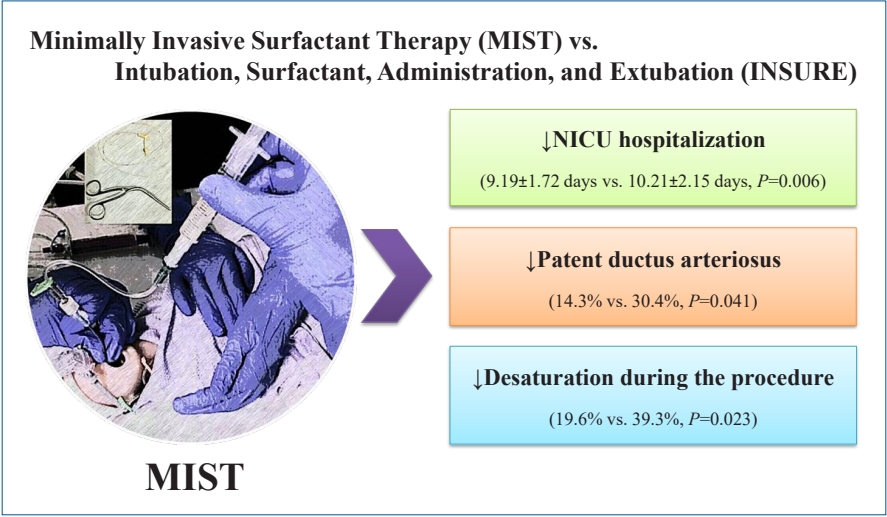
Question: Are the short-term outcomes of minimally invasive surfactant therapy (MIST) relatively superior to those of INtubation, SURfactant administration, and Extubation (INSURE) in preterm infants with respiratory distress syndrome (RDS)?
Finding: MIST could be an appropriate substitution for INSURE in preterm infants with RDS since it reduced hospitalization time and number of side effects.
Meaning: MIST is recommended for surfactant administration for its proven advantages over the INSURE technique.
- Review Article
- Neurology
- Autoimmune encephalitis and epilepsy: evolving definition and clinical spectrum
- Joo Hee Seo, Yun-Jin Lee, Ki Hyeong Lee, Elakkat Gireesh, Holly Skinner, Michael Westerveld
- Clin Exp Pediatr. 2020;63(8):291-300. Published online August 16, 2019
-
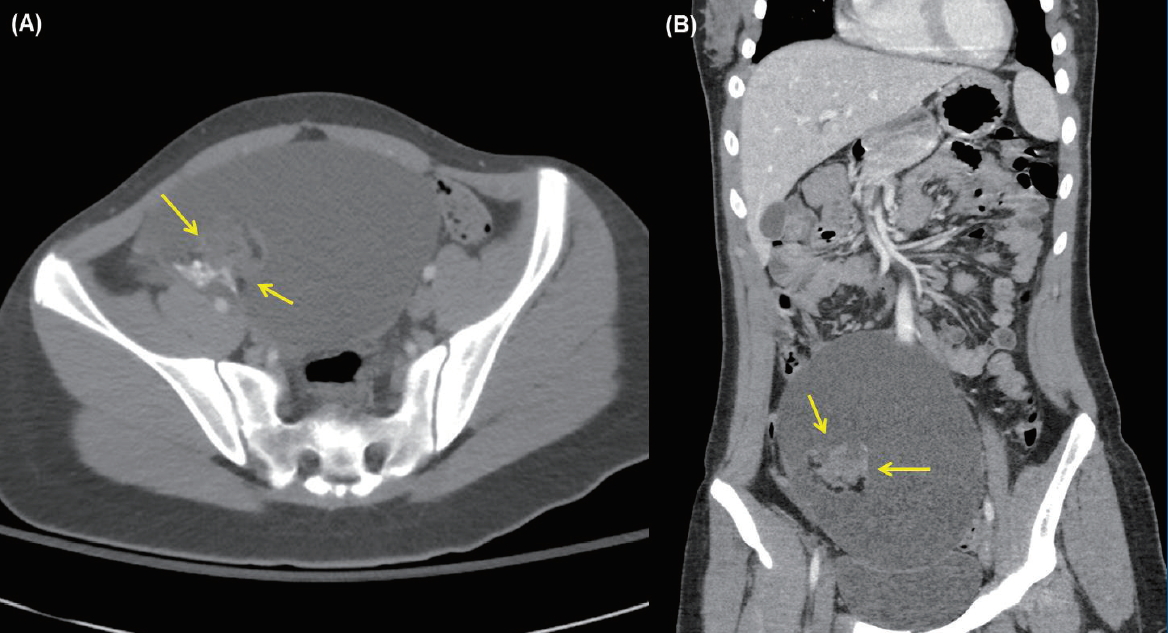
Advances in autoimmune encephalitis studies in the past 10 years have led to the identification of new syndromes and biomarkers that have transformed the diagnostic approach to the disorder. The disorder or syndrome has been linked to a wide variety of pathologic processes associated with the neuron-specific autoantibodies targeting intracellular and plasma membrane antigens. However, current criteria for autoimmune encephalitis...
- Nephrology (Genitourinary)
- Renal replacement therapy in neonates with an inborn error of metabolism
- Heeyeon Cho
- Clin Exp Pediatr. 2019;62(2):43-47. Published online November 7, 2018
-
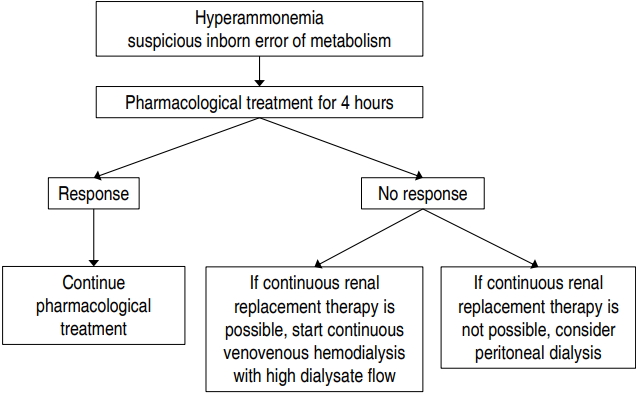
Hyperammonemia can be caused by several genetic inborn errors of metabolism including urea cycle defects, organic acidemias, fatty acid oxidation defects, and certain disorders of amino acid metabolism. High levels of ammonia are extremely neurotoxic, leading to astrocyte swelling, brain edema, coma, severe disability, and even death. Thus, emergency treatment for hyperammonemia must be initiated before a precise diagnosis is...
- Acute kidney injury and continuous renal replacement therapy in children; what pediatricians need to know
- Myung Hyun Cho, Hee Gyung Kang
- Clin Exp Pediatr. 2018;61(11):339-347. Published online October 23, 2018
-

Acute kidney injury (AKI) is characterized by abrupt deterioration of renal function, and its diagnosis relies on creatinine measurements and urine output. AKI is associated with higher morbidity and mortality, and is a risk factor for development of chronic kidney disease. There is no proven medication for AKI. Therefore, prevention and early detection are important. Physicians should be aware of...
- Original Article
- Genetics and Metabolism
- Clinical and molecular characterization of Korean children with infantile and late-onset Pompe disease: 10 years of experience with enzyme replacement therapy at a single center
- Min-Sun Kim, Ari Song, Minji Im, June Huh, I-Seok Kang, Jinyoung Song, Aram Yang, Jinsup Kim, Eun-Kyung Kwon, Eu-Jin Choi, Sun-Ju Han, Hyung-Doo Park, Sung Yoon Cho, Dong-Kyu Jin
- Clin Exp Pediatr. 2019;62(6):224-234. Published online October 4, 2018
-
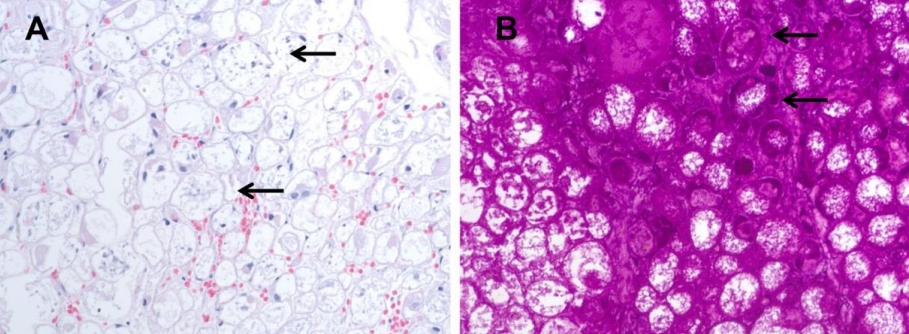
Purpose: Pompe disease (PD) is an autosomal recessive disorder caused by a deficiency of acid alphaglucosidase resulting from pathogenic GAA variants. This study describes the clinical features, genotypes, changes before and after enzyme replacement therapy (ERT), and long-term outcomes in patients with infantile-onset PD (IOPD) and late-onset PD (LOPD) at a tertiary medical center. Methods: The medical records of 5 Korean...
- Review Article
- Nephrology (Genitourinary)
- Atypical hemolytic uremic syndrome and eculizumab therapy in children
- Seong Heon Kim, Hye Young Kim, Su Young Kim
- Clin Exp Pediatr. 2018;61(2):37-42. Published online February 28, 2018
-
Hemolytic uremic syndrome (HUS) is often encountered in children with acute kidney injury. Besides the well-known shiga toxin-producing
Escherichia coli -associated HUS, atypical HUS (aHUS) caused by genetic complement dysregulation has been studied recently. aHUS is a rare, chronic, and devastating disorder that progressively damages systemic organs, resulting in stroke, end-stage renal disease, and death. The traditional treatment for aHUS is...
- Case Report
- Oncology
- Relapsed Wilms' tumor with multiple brain metastasis
- Akın Akakın, Baran Yılmaz, Murat Şakir Ekşi, Özlem Yapıcıer, Türker Kılıç
- Clin Exp Pediatr. 2016;59(Suppl 1):S96-S98. Published online November 30, 2016
-
Wilms' tumor is the most common malignant renal tumor in childhood. The brain metastasis of a Wilms' tumor with anaplastic histopathology is rare. We present the case of an 8-year-old girl with Wilms' tumor, who presented with multiple brain metastases 5 years after her primary diagnosis. The brain masses were diagnosed after a generalized tonic-clonic seizure attack. The big solid...
- Esthesioneuroblastoma in a boy with 47, XYY karyotype
- Hee Cheol Jo, Seong Wook Lee, Hyun Joo Jung, Jun Eun Park
- Clin Exp Pediatr. 2016;59(Suppl 1):S92-S95. Published online November 30, 2016
-
Neuroblastomas are sometimes associated with abnormal constitutional karyotypes, but the XYY karyotype has been rarely described in neuroblastomas. Here, we report a case of an esthesioneuroblastoma in a boy with a 47, XYY karyotype. A 6-year-old boy was admitted to our hospital because of nasal obstruction and palpable cervical lymph node, which he first noticed several days previously. A polypoid...
- Original Article
- Cardiology
- Clinical outcome of patients with refractory Kawasaki disease based on treatment modalities
- Hyun Jung Kim, Hyo Eun Lee, Jae Won Yu, Hong Ryang Kil
- Clin Exp Pediatr. 2016;59(8):328-334. Published online August 24, 2016
-
Purpose Although a significant number of reports on new therapeutic options for refractory Kawasaki disease (KD) such as steroid, infliximab, or repeated intravenous immunoglobulin (IVIG) are available, their effectiveness in reducing the prevalence of coronary artery lesions (CAL) remains controversial. This study aimed to define the clinical characteristics of patients with refractory KD and to assess the effects of adjuvant therapy...
- Review Article
- Allergy
- A practical view of immunotherapy for food allergy
- Tae Won Song
- Clin Exp Pediatr. 2016;59(2):47-53. Published online February 29, 2016
-
Food allergy is common and sometimes life threatening for Korean children. The current standard treatment of allergen avoidance and self-injectable epinephrine does not change the natural course of food allergy. Recently, oral, sublingual, and epicutaneous immunotherapies have been studied for their effectiveness against food allergy. While various rates of desensitization (36% to 100%) and tolerance (28% to 75%) have been...
- Case Report
- Alveolar rhabdomyosarcoma with massive disseminated intravascular coagulopathy treated with systemic chemotherapy
- Byung Gyu Yoon, Hee Jo Baek, Burm Seok Oh, Dong Kyun Han, Yoo Duk Choi, Hoon Kook
- Clin Exp Pediatr. 2015;58(12):505-508. Published online December 22, 2015
-
It is uncommon for pediatric patients with rhabdomyosarcoma to present with clinical and/or laboratory features of disseminated intravascular coagulation (DIC). We report a case of metastatic alveolar rhabdomyosarcoma with severe bleeding because of DIC in a 13-year-old boy. He experienced persistent oozing at the site of a previous operation, gross hematuria, and massive epistaxis. Two weeks after initiating combination chemotherapy...
- Original Article
- Initial steroid regimen in idiopathic nephrotic syndrome can be shortened based on duration to first remission
- Hee Sun Baek, Ki-Soo Park, Hee Gyung Kang, Cheol Woo Ko, Min Hyun Cho
- Clin Exp Pediatr. 2015;58(6):206-210. Published online June 22, 2015
-
Purpose The use of a 12-week steroid regimen (long-term therapy, LT) for the first episode of idiopathic nephrotic syndrome (NS) reportedly induces a more sustained remission and lower relapse rate than previous regimens, including an 8-week steroid regimen (short-term therapy, ST). Here, we assessed the potential for selective application of 2 steroid regimens (LT vs. ST) based on the days to...
- Ten years of experience in the prevention of mother-to-child human immunodeficiency virus transmission in a university teaching hospital
- Jung-Weon Park, Tae-Whan Yang, Yun-Kyung Kim, Byung-Min Choi, Hai-Joong Kim, Dae-Won Park
- Clin Exp Pediatr. 2014;57(3):117-124. Published online March 31, 2014
-
Purpose Administration of antiretroviral drugs to mothers and infants significantly decreases mother-to-child human immunodeficiency virus (HIV) transmission; cesarean sections and discouraging breastfeeding further decreases this risk. The present study confirmed the HIV status of babies born to mothers infected with HIV and describes the characteristics of babies and mothers who received preventive treatment.
Methods This study retrospectively analyzed medical records of nine infants...
- Review Article
- Clinical utilization of cord blood over human health: experience of stem cell transplantation and cell therapy using cord blood in Korea
- Young-Ho Lee
- Clin Exp Pediatr. 2014;57(3):110-116. Published online March 31, 2014
-
Cord blood (CB) has been used as an important and ethical source for hematopoietic stem cell transplantation (SCT) as well as cell therapy by manufacturing mesenchymal stem cell, induced pleuripotential stem cell or just isolating mononuclear cell from CB. Recently, the application of cell-based therapy using CB has expanded its clinical utility, particularly, by using autologous CB in children with...
- Antibiotics resistance of
Helicobacter pylori and treatment modalities in children withH. pylori infection - Ji-Hyun Seo, Hyang-Ok Woo, Hee-Shang Youn, Kwang-Ho Rhee
- Clin Exp Pediatr. 2014;57(2):67-71. Published online February 24, 2014
-
Pediatric infection with
Helicobacter pylori may occur early in childhood and persist lifelong. Global pediatric clinical studies have reported a decreasing tendency in the overall rate ofH. pylori eradication. In pediatric patients withH. pylori infection, pediatric patients with peptic ulcer, and the first-degree relatives of patients with a history of gastric cancer, it is commonly recommended thatH....
- Mechanisms of immune tolerance to allergens in children
- Umut C. Kucuksezer, Cevdet Ozdemir, Mübeccel Akdis, Cezmi A. Akdis
- Clin Exp Pediatr. 2013;56(12):505-513. Published online December 20, 2013
-
Because the prevalence of allergic diseases has significantly increased in recent years, understanding the causes and mechanisms of these disorders is of high importance, and intense investigations are ongoing. Current knowledge pinpoints immune tolerance mechanisms as indispensable for healthy immune response to allergens in daily life. It is evident that development and maintenance of allergens-pecific T cell tolerance is of...
- Original Article
- High-dose chemotherapy and autologous peripheral blood stem cell transplantation in the treatment of children and adolescents with Ewing sarcoma family of tumors
- Juhee Seo, Dong Ho Kim, Jung Sub Lim, Jae-Soo Koh, Ji Young Yoo, Chang-Bae Kong, Won Seok Song, Wan Hyeong Cho, Dae-Geun Jeon, Soo-Yong Lee, Jun Ah Lee
- Clin Exp Pediatr. 2013;56(9):401-406. Published online September 30, 2013
-
Purpose We performed a pilot study to determine the benefit of high-dose chemotherapy and autologous peripheral blood stem cell transplantation (HDCT/autoPBSCT) for patients with Ewing sarcoma family of tumors.
Methods We retrospectively analyzed the data of patients who received HDCT/autoPBSCT at Korea Cancer Center Hospital. Patients with relapsed, metastatic, or centrally located tumors were eligible for the study.
Results A total of 9 patients (3...
- Intravenous fluid prescription practices among pediatric residents in Korea
- Jiwon M. Lee, Younghwa Jung, Se Eun Lee, Jun Ho Lee, Kee Hyuck Kim, Ja Wook Koo, Young Seo Park, Hae Il Cheong, Il-Soo Ha, Yong Choi, Hee Gyung Kang
- Clin Exp Pediatr. 2013;56(7):282-285. Published online July 19, 2013
-
Purpose Recent studies have established the association between hypotonic fluids administration and hospital-acquired hyponatremia in children. The present paper investigated the pattern of current practice in intravenous fluid prescription among Korean pediatric residents, to underscore the need for updated education.
Methods A survey-based analysis was carried out. Pediatric residents at six university hospitals in Korea completed a survey consisting of four questions. Each...
- Combined chemotherapy and intra-arterial chemotherapy of retinoblastoma
- Saerom Choi, Jung Woo Han, Hyosun Kim, Beom Sik Kim, Dong Joon Kim, Sung Chul Lee, Chuhl Joo Lyu
- Clin Exp Pediatr. 2013;56(6):254-259. Published online June 21, 2013
-
Purpose Retinoblastoma (RB) is the most common primary malignant intraocular tumor in children. Although systemic chemotherapy has been the primary treatment, intra-arterial chemotherapy (IAC) represents a new treatment option. Here, we performed alternate systemic chemotherapy and IAC and retrospectively reviewed the efficacy and safety of this approach.
Methods Patients diagnosed with intraocular RB between January 2000 and December 2011 at Severance Children's Hospital,...
- Continuous renal replacement therapy in neonates weighing less than 3 kg
- Young Bae Sohn, Kyung Hoon Paik, Hee Yeon Cho, Su Jin Kim, Sung Won Park, Eun Sun Kim, Yun Sil Chang, Won-Soon Park, Yoon-Ho Choi, Dong-Kyu Jin
- Clin Exp Pediatr. 2012;55(8):286-292. Published online August 23, 2012
-
Purpose Continuous renal replacement therapy (CRRT) is becoming the treatment of choice for supporting critically ill pediatric patients. However, a few studies present have reported CRRT use and outcome in neonates weighing less than 3 kg. The aim of this study is to describe the clinical application, outcome, and complications of CRRT in small neonates.
Methods A retrospective review was performed in 8...
- Review Article
- Treatment of high-risk neuroblastoma
- Ki Woong Sung
- Clin Exp Pediatr. 2012;55(4):115-120. Published online April 30, 2012
-
Although high-dose chemotherapy and autologous stem cell transplantation (HDCT/autoSCT) have improved the prognosis for patients with high-risk neuroblastoma (NB), event-free survival rates remain in the range of 30 to 40%, which is unsatisfactory. To further improve outcomes, several clinical trials, including tandem HDCT/autoSCT, high-dose 131I-metaiodobenzylguanidine treatment, and immunotherapy with NB specific antibody, have been undertaken and pilot studies have reported...
- Case Report
- Acute treatment of hyperammonemia by continuous renal replacement therapy in a newborn patient with ornithine transcarbamylase deficiency
- Hyo Jeong Kim, Se Jin Park, Kook In Park, Jin Sung Lee, Ho Sun Eun, Ji Hong Kim, Jae Il Shin
- Clin Exp Pediatr. 2011;54(10):425-428. Published online October 31, 2011
-
Ornithine transcarbamylase (OTC) deficiency is well known as the most common inherited disorder of the urea cycle, and 1 of the most common causes of hyperammonemia in newborns. We experienced a case of a 3-day-old boy with OTC deficiency who appeared healthy in the first 2 days of life but developed lethargy and seizure soon afterwards. His serum ammonia level...
- Original Article
- Short term outcomes of topiramate monotherapy as a first-line treatment in newly diagnosed West syndrome
- Gyu Min Lee, Kyung Suk Lee, Eun Hye Lee, Sajun Chung
- Clin Exp Pediatr. 2011;54(9):380-384. Published online September 30, 2011
-
Purpose To investigate the efficacy of topiramate monotherapy in West syndrome prospectively.
Methods The study population included 28 patients (15 male and 13 female children aged 2 to 18 months) diagnosed with West syndrome. After a 2-week baseline period for documentation of the frequency of spasms, topiramate was initiated at 2 mg/kg/day. The dose was increased by 2 mg/kg every week to a...
- Review Article
- Optimal oxygen saturation in premature infants
- Meayoung Chang
- Clin Exp Pediatr. 2011;54(9):359-362. Published online September 30, 2011
-
There is a delicate balance between too little and too much supplemental oxygen exposure in premature infants. Since underuse and overuse of supplemental oxygen can harm premature infants, oxygen saturation levels must be monitored and kept at less than 95% to prevent reactive oxygen species-related diseases, such as retinopathy of prematurity and bronchopulmonary dysplasia. At the same time, desaturation below...
- Nonpharmacological management and psychosocial support for children and adolescents with type 1 diabetes
- Jae Ho Yoo
- Clin Exp Pediatr. 2011;54(2):45-50. Published online February 28, 2011
-
Compared to that in the Caucasian population, type 1 diabetes mellitus (T1DM) incidence rates are very low in Koreans. Therefore, compared to the recent development of pharmacological therapy applicable to Korean children with T1DM, interest in nonpharmacological therapy and psychosocial support systems remains low, as is the development of Korean-style T1DM education programs for therapeutic application. Children who have been...
-

-
-

-

-
Impact Factor4.2
-
6.52022CiteScore92nd percentilePowered by







